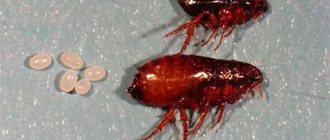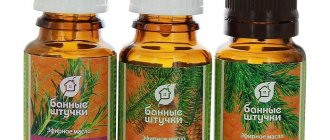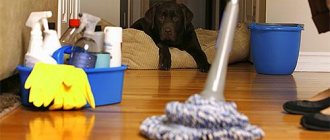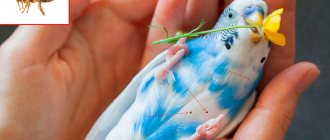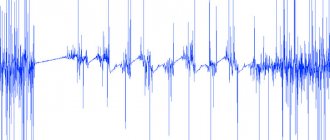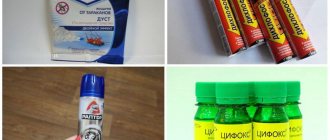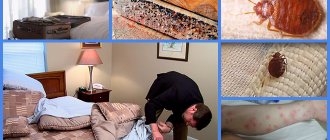One of the most common types of insects that parasitize mammals is fleas. Basic information:
- without wings;
- size from 1 to 5 mm;
- jump up to 0.5 meters;
- feed on the blood of the mammal on which they live;
- The female lays eggs, from which the larva emerges. The larva then makes a cocoon for itself and after a while pupates. The final stage of the life cycle is the transformation of the pupa into an adult.
Cats can get fleas not only when they are kept outside, but also when they live permanently with a person in an apartment or house. Therefore, every owner must be able to promptly recognize parasites and be able to remove them without harm to the health of the pet.
Danger of insect parasites:
- are carriers of helminths, infecting animals and, often, humans;
- the saliva of these insects can cause an allergic reaction;
- bites are accompanied by itching, which causes scratching on the body. These wounds turn into entrance gates for infection of the body with pathogenic microflora from the external environment;
- numerous insects are capable of drinking large amounts of blood, which for small kittens inevitably ends in anemia;
- Constant scratching causes nervousness, which leads to destabilization of mental health.
It’s quite easy to protect your furry friend from these problems by using the advice of experts, as well as pharmaceuticals and folk recipes.
Rules for treating cats for fleas
If the cat walks freely around the yard and garden plot, flea treatment should be carried out at least once every two months. For cats that do not leave the apartment, preventive measures are carried out once every three months. You should not think that if the cat has not crossed the threshold of the home, fleas will bypass it. You can bring them yourself on clothes or shoes. This is why fleas appear in houses that are rarely cleaned even in the absence of pets.
If you use special drops for fleas that are applied to the withers, carefully read the instructions. It may indicate that the cat needs to be washed before using the drops. If there is no such clarification, remember: the cat is not bathed three days before and after treatment.
Be sure to use medications that are intended only for cats! Some substances contained in dog products can cause irreparable harm to a cat.
If you treated your animal with drops or spray, do not allow him to lick his fur for at least another half hour.
To completely get rid of fleas, treat the area where your cat rests, her toys, and her scratching post. Thoroughly vacuum all surfaces that cannot be washed: carpets, upholstered furniture.
Follow the dosage indicated on the package. An insufficient amount of the drug applied will not have the desired effect, and an excessive amount can lead to allergies.
It’s easy to guess that your cat has fleas:
- the animal becomes anxious, restless, freezes, as if listening to something, and then makes sudden jumps;
- often itches, licks fur, tries to catch insects with teeth; tiny wounds appear on the skin;
- in case of severe infestation, adult individuals are detected visually – for example, on the animal’s face.
To find out if your pet has fleas, stand him on a large piece of white paper and comb him with a fine-toothed comb. If several insects fell on the paper or dark particles of flea excrement woke up, it’s time to sound the alarm.
Ridding an animal of fleas is quite simple: in any pet store or veterinary pharmacy you will find a large assortment of different shampoos, sprays, powders, collars and drops intended for this purpose.
Side effects
All prophylactic drugs intended to combat parasites are toxic. Drops released for treating kittens are usually classified as moderately toxic substances. It is important to understand that the conditional safety of the drops implies exclusively external use and the absence of an individual allergic reaction.
If you are treating a kitten with an unknown medical history, you should use the safest possible drops and consult your veterinarian first. In most cases, kittens picked up on the street or bought at a poultry market are infected not only with fleas, but also with worms. In case of mixed invasion, it is much more reasonable to use complex drugs (for external and internal parasites) in the form of drops.
Kitten itches after flea drops
In rare cases, if there is an individual intolerance to the active ingredients of the drops, the animal may experience an allergic reaction. If the kitten itches after flea drops, it is necessary to inspect the treatment area. Alarming symptoms are: redness, swelling and local fever. If you notice symptoms of an allergic reaction, the remaining droplets must be washed off from the kitten’s fur and skin.
In the absence of an allergic reaction, after treatment with drops, the kitten may itch during the day. The fact is that most drops quickly paralyze fleas, but the death of parasites can occur within several hours. An allergic reaction to already inflicted flea bites can last up to 12–20 hours. In addition, gentle drugs can only affect adults. In this case, the treatment is repeated after 4–10 days (according to the instructions or prescription of the veterinarian).
The kitten licked the drops and became poisoned - what to do?
What to do if the kitten licked the drops and got poisoned? Generally recognized symptoms of poisoning are: drooling, apathy, decreased body temperature, nausea and vomiting . If such symptoms are observed in a pet, it is necessary to immediately give it absorbent agents.
Monitor the dynamics carefully and provide your pet with plenty of warm drink. If symptoms worsen or your kitten develops tremors or seizures, contact your veterinarian immediately! In case of overdose or poisoning with flea drops, the kitten can die in a matter of hours.
Anti-flea collars
One of the most popular remedies for animals that “walk on their own.” Collars such as “Barrier” or “Beafar” retain their properties for up to five months. There is no need to worry that your pet will be uncomfortable in the collar: full adaptation takes no more than one or two days, even for adult animals that have never worn a collar before.
The negative points include the following:
- presence of a specific odor;
- Sometimes the hair on the animal's withers thins.
Collars are produced for adult animals and kittens.
Flea drops
Perhaps the most popular remedy. It is easy to apply, does not cause discomfort, and is effective for two months on fleas and at least one month on ticks. Place of application: along the spine, starting from the shoulder blades. Some owners believe that the drops drive away fleas only from the area to which they are applied, but we are probably talking about cheap, ineffective drugs, or the dosage was not followed. If everything is done correctly, you can forget about blood-sucking parasites on your pet’s body for two months.
Folk remedies
In addition to professional means of fighting insects, there are many folk ones. They are quite effective and can be used if you do not have the opportunity to visit a pet store or veterinary pharmacy.
Salt
To treat your cat you will need a small basin with high sides, water and table salt. For every liter of water, take two tablespoons of salt. Dissolve the salt in warm water, place your pet in the basin up to its neck and hold in this position for at least five minutes. After this, rinse the cat's fur thoroughly with clean water, dry with a towel and comb. The salt solution has a detrimental effect on flea eggs and larvae; adults cannot tolerate it either.
By the way, the same remedy is used to treat abscesses in cats: moisten a clean cloth with a hot saline solution and apply it to the abscess for 5-10 minutes several times a day. A positive result is achieved very quickly.
Sagebrush
The familiar wormwood has proven itself well as a remedy for fleas in cats. Brew a tablespoon of pharmaceutical wormwood with a glass of boiling water, cool slowly under the lid and wet your pet's fur while warm.
For greater effectiveness, you can add the same amount of tansy to the wormwood. However, be careful: if you see that your pet is not feeling well, immediately wash off the broth and give him an antihistamine. Cats usually tolerate herbal treatment well, but in some cases an allergic reaction may occur.
Coniferous sawdust
Fleas do not like the smell of pine needles and pine sawdust. If your cat is used to sleeping on a mattress, make him a special one - not tightly stuffed with pine or spruce sawdust. You can put a couple of sprigs of dry wormwood in it. Your pet will smell like a Christmas tree and not a single flea will bite on it!
How to remove fleas from cats and kittens
If a pregnant cat has fleas, it is imperative to remove them before the offspring appear. In this case, you cannot do without consulting an experienced veterinarian, since folk remedies or those bought at random can harm not only the expectant mother, but also her babies. Bathing (unless your cat is a “fan” of water treatments) is quite stressful for a pregnant cat. It is especially dangerous to bathe her in the later stages due to the threat of premature birth. Many veterinarians recommend using Frontline spray during this period. It can be used not only to treat a pregnant cat, but even for kittens from seven days of age. The Stronghold spray has proven itself well. Bars is quite suitable as a budget option.
Instructions for use and precautions
If you are interested in how to use flea spray for cats, you can refer to the instructions for the product. The instructions indicate that due to the toxicity of the drug, it is better to treat the animal in the fresh air. The owner should wear work clothes, gloves, and a respirator.
After disinfection, clothes should be washed, and hands and face should be washed thoroughly with soap.
When a cat is treated, before using flea spray for a cat, you need to buy a special cervical collar. This will protect your pet from getting the product into the respiratory tract. If you don’t have a unit, you can build it yourself from cardboard, foam rubber or plastic.
In addition to the funnel collar, you can protect the animal with a muzzle. For cats, it is only needed while spraying the flea spray; when the product dries, the restrictor can be removed.
You need to calculate the dose taking into account the age, weight, length and thickness of your pet’s fur. On average, this figure is equal to 1-2 spray presses per 1 kg of animal weight.
Flea sprays for cats are sprayed according to this algorithm:
- The animal is dressed in a protective collar.
- Shake the bottle with the mixture.
- Part the fur and spray the preparation onto the pet’s skin at a distance of 20-25 cm from the surface. In this case, the bottle must be held vertically.
- The head is treated by applying a small amount of the drug to the glove. Do not spray from the bottle, as the drug may get into the eyes or respiratory system. You need to wipe the ears and face, avoiding the eyes, nose and lips. If the product gets into your eyes, be sure to rinse them with water.
- 30 minutes after treatment, the pet should be combed with a fine-toothed comb.
- Smooth-haired breeds can be completely treated without a spray bottle by wiping the skin with a glove.
- Repeated disinfection, if necessary, is carried out no earlier than 1-2 weeks later.
When using sprays, do not pet your pet immediately after treatment. It is better to postpone this for 10-14 days. At the same time, it is not allowed to bathe your pet if the drug does not involve rinsing off.
How to get rid of fleas on a kitten
Removing fleas from kittens has its own characteristics.
- The smallest ones - about a month old - will have to urgently get acquainted with warm water and zoo shampoo, and in case of its absence - with tar or even laundry soap. The kitten's fur is generously moistened with whipped foam, leaving only the head dry, left for four minutes, then washed generously with running water and dried with a terry towel.
- If the kitten is at least two months old, you can wash it with shampoo that is used against fleas in adult animals. If at this age the kitten does not have contact with its mother and lives in another house (for example, you bought a two-month-old baby), the range of products used expands significantly. These can be drops on the withers intended for kittens, sprays, powder or powders.
- Starting at three months, the kitten is treated for fleas like an adult animal and wears a flea collar.
At what age can drops be used?
Fleas are external parasites of pets. Flea bites are very itchy and can cause allergies and dermatitis in the animal. If your pet is left untreated, its fur may fall out. The body becomes vulnerable to worms and various infections. Flea infestation leads to the development of anemia, which often ends in death.
A kitten can become infected immediately after birth. This occurs if the mother was not treated before pregnancy. Babies can be treated from the age of 3 months.
Before reaching this age, fleas are removed by hand, the kittens are bathed with a mild shampoo, making sure that it does not get into the baby’s eyes, mouth and nose. After bathing, you need to dry the coat with a hairdryer. Do not allow the kitten into a cold, drafty room for 8–10 hours. By licking newborns, the cat removes some of the fleas. It is advisable to wash the bed on which the cat family sleeps every day. You can comb babies with a small soft comb.
The drops are intended for kittens at least six months old. In pet stores and veterinary pharmacies you can find special gentle drops for babies, but they also should not be used before babies are 12 weeks old.
Important! Products such as spray, special collar, powder, and aerosol are not suitable for children. Moreover, if you put a collar on a kitten too early, this can lead to stunted growth and development of the pet.
In the apartment
To prevent fleas from returning to their favorite place in your pet’s fluffy fur, it is necessary to disinfect the entire apartment.
Professional pest control
The most effective method is temperature treatment of housing using a heat gun. The pest control team will assess how infested the apartment is and, in accordance with this, will choose a method for exterminating the insects. All you need to do is prepare your home for the arrival of specialists and pay for their services. Don’t be alarmed if fleas appear in your apartment again after a few days. Surely their eggs or larvae remained in the deep crevices. They will not survive contact with treated surfaces. This phenomenon can last up to 4-5 weeks, after which the insects will leave you alone.
Self-processing
If you do not have the opportunity or desire to use the services of professionals, you can disinfect the apartment yourself. For this purpose you will need an insecticidal spray or powder.
Aerosol treatment
- Before you begin disinfection, remove all living things from the apartment: children and adults, except for your assistants, animals, birds, aquarium fish and indoor plants.
- Throw out the trash in advance and get rid of unnecessary things.
- Move furniture away from the walls. If there is a rug hanging on the wall, remove it.
- Treat all items in the apartment with the selected aerosol, including upholstered furniture, clothes, shoes, and bed linen. Try to get the drug into every crevice.
- Close windows and doors tightly and leave your home for several hours - preferably overnight. The next day, ventilate the apartment properly, wash and wash everything that has been treated.
Powder treatment
Unlike aerosols, powdered insecticides are less effective. You will have to wait much longer for the desired result. But you don’t have to leave your apartment. Powders are poured in places where fleas are most concentrated: behind baseboards, in corners, in hard-to-reach crevices. Upon contact with the powder, not only eggs and larvae, but also adult insects die.
Quick answers to common questions
How long does it take for flea drops for cats to work?
The effect is noticeable in the first hour after treatment. The protective effect of the drug remains for 1-2 months.
When can you wash your cat after flea drops?
Each manufacturer sets its own deadlines, but on average you can wash the animal 2-3 days after treatment.
How often can you give flea drops to your cat?
One treatment protects the animal for up to 1-2 months. More precisely, the duration of protection should be looked at in the instructions for the specific drug.
Can a pregnant cat receive flea drops?
Veterinarians do not recommend doing this, but if the situation is serious and there is a risk of death of the animal, then drops can be used. But it is better to consult a doctor.
Where do fleas go after treating cats with drops?
Adults die, but some parasites can leave the animal and hide in textiles (carpet, bedding, sofa). To be sure to get rid of parasites, it is recommended to simultaneously treat your apartment for fleas.
Can flea drops for dogs be given to cats?
It is impossible, because the drugs are developed in accordance with the development and structure of a specific animal species. If you apply dog product to a cat, it can become poisoned.
What is the price of flea drops for cats?
The average price of drugs is in the range of 100-300 rubles. At the same time, the products are highly effective. It is especially worth noting Russian manufacturers - Bars, Doctor Zoo.
Effective flea control
One of the most popular remedies against fleas and other blood-sucking insects in cats is drops called “Bars”, which combines a very reasonable price and high quality. These drops can be used on kittens from 2.5 months and adult cats. Watch the dosage! This is very important due to the increased sensitivity of cats to permethrin, which is the active ingredient of the drug. A single use of Barsa relieves the animal of fleas and ticks for a period of one to two months.
Ways to prevent itching in animals
Simple rules will help protect your cat from itching:
- It is necessary to wash the bedding once a month, wash the dishes daily, and buy high-quality food enriched with vitamins and minerals that will support the immune system.
- If your pet walks outside, wear a flea collar and use drops and shampoos.
- Be sure to keep your cats ears clean.
You should not immediately think that the cat is itching from drops: this is masking a more serious disease. If he does not have fleas, but the animal is itching, do not delay a visit to the veterinarian, this will protect the cat from damage to the skin and prevent serious infection.
https://meowkiss.ru/kogda-mozhno-pomyt-kotenka-posle-kapel-ot-blox/ https://apest.ru/blohi/blohi-u-koshek/koshka-cheshetsya-posle-kapel-ot- bloh/

